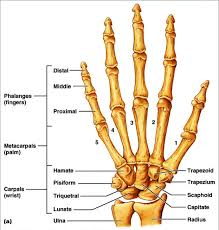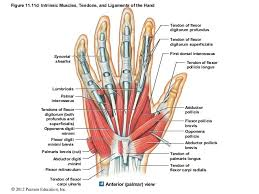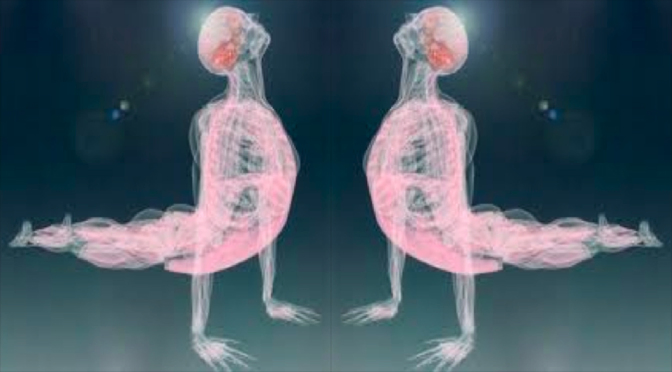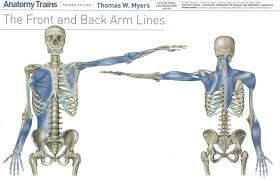Pop quiz: What structures are involved in EVERY Olympic lift AND most exercises in a gym setting?
Who answered glutes? Well – you could be right. And hey, if you like Thomas Myers’ analogy that the body is one muscle with 600 fascial pockets then you could say that every structure is involved. But think about what do you use to grip a barbell, dumbbell, TRX Suspension or Rip Trainer, Kettlebell and just about any other piece of equipment on the gym floor. Yes – the things that dangle at the ends of your biceps and triceps! Your hands.
The position of your hands and any variance in your grip will affect the way your body deals with the load, whether that is body weight or any form of external mass.
A simple way to feel this is to do the following movement: stand tall with your arms extended in front of you at chest height. Be aware of your posture, maintain a neutral spine please, the tendency for a lot of people when they reach out into this position is to go into a kyphotic curve. Start with your palms facing the floor (pronated). Simply turn your palms slowly into a palms up (supinated) position.
Yer, so what Chaddy, I can do that – big deal! Do it again for me but this time bring your attention to your shoulder blades. Remember to check your posture, and slowly turn your hands from a pronated to a supinated position. Did you feel it? Could you feel when you moved your hands it affected your scapulae? Could you feel your ‘scaps’ go from a protracted position with the hands pronated into a retracted position with the hands supinated? It may have only been a little movement, but that small amount of motion with an external mass will change the line of force mitigation throughout your system.
A quick word on the difference between hand position and grip. There are many different grips. Open handed, cupped hand or closed fist to mention a few. Each of the grips can be done in a different hand position. For example, you can perform a closed grip in a pronated or supinated position. The point here is going from pronated to supinated didn’t change the grip, it changed the hand position. Commonly we have been a little confused in the fitness setting in thinking that changing the hand position has changed the grip. Don’t get me wrong, changing either the grip or the hand position will change the stress on the body – but just know that there is a difference between grip and position.
So why would the hand play such a pivotal role in how the body deals with force mitigation? Perhaps the answer lies in the anatomy of the hand.
Let’s start with the skeletal system. In your Cert IV in Fitness, you were probably taught about carpals, metacarpals and phalanges. Let’s look at things proximally to distally:
The radius and ulna: now although they’re not technically in the hand, these two bones are directly affected by the function of the hand and are actually the reason the hand can supinate or pronate.
The carpals are next and at a Cert IV level they’re usually left at that. But it’s important to note there are eight carpals and they articulate with each other and all have a
After that there’s the metacarpals. Numbered one (being the thumb) to five, medially to laterally.
To round it off there is the phalanges. Each finger has three phalanges with the exception of the thumb. It only has two. Do you as a PT need to remember the name of every bone of the hand at all times? Probably not. The big take away here is there are 29 bones including two sesamoid bones at the distal end of the thumb’s metacarpal, however this can vary from person to person – apparently some people have one, some have two, it varies. That makes up about ¼ of the bones in your body. All of these bones articulate at 29 places (joints). As you are probably starting to see, there is a lot of similarity between the hand and the foot. If you look at our cousins in the animal kingdom, the visual similarities are even more noticeable.

Just like the foot, the hand has many nerves and has a huge amount of sensory receptors that measure things like temperature and pressure. Think about when you shake someone’s hand. You can feel how much pressure they are applying and then you are usually able to match that appropriately.
To help us understand the function of the hand, we need to look at all of the connective tissue and bones combined. One of the best ways to do that is through the Anatomy Trains descriptions from Thomas Myers. There are four Arm Lines. Two superficial and two deep, in both the front and back of each arm. It’s important to remember these lines interact with the arm lines as well as the other myofascial lines. As a brief overview:
The Deep Front Arm Line runs from pec minor, along the biceps brachii and finishes at the thumb.
The Deep Back Arm Line runs from the rhomboids and levator scapulae, along the rotator cuff musculature, then the triceps brachii all the way to the outside of the little finger.
Both Deep Arm Lines work together to help stabilize the shoulder all the way down to the tips of the fingers.
The Superficial Front Arm Line starts at the pec major and the lats, runs under the biceps brachii via the medial intermuscular septum through the wrist and hand flexors.
The Superficial Back Arm Line starts trapezius, runs via the deltoid, lateral intermuscular septum, then the wrist and into the dorsal surface of the hand.
The Superficial lines are involved in controlling the motions of the arm. The Front line anterially and the Back line posteriorially. The superficial back arm line also helps limit and contain the work of the superficial front arm line.
So what does that all mean? It means that how you position your hand will change the transfer of the load to the shoulder. This in turn will transfer differently throughout the rest of the body.
Try this: grab a kettlebell (or any form or external mass) and perform a ‘suitcase carry’. Your first instinct will be to perform the move with your thumb facing forward. Do that and feel what you feel. Now don’t change the grip, but change the hand position by externally rotating the hand, and get to palm facing forward. Perform the move again. Did you feel a difference? Neither of those hand positions is right or wrong. They just impose a different demand on the body. To people observing you, they may look totally the same. To you doing it, they will both feel different. You’ve changed the load profile through your system.
How can we use this information with our clients?
Knowing that hand grip and position change the load pattern (especially up to the shoulder) can help you help your clients perform some movements without any impingement or niggles. Even when doing a deadlift, chin-up or push-up, you will be able to change the tissue load throughout the body by simply changing the way the hand is positioned. For the deadlift and chin-up simply going from over to under-grip will make a difference. The push-up now has lots different variations just by changing the hand position. With regards to grip, try doing that deadlift with a loose grip and then do one trying to squeeze the bar as hard as you can – you should notice a difference!
Being aware of where the hands are facing and how hard a client is gripping something will help you help your clients with shoulder stability and mobility. As Anatomy Trains tells us, there is a direct link between the hands and the shoulders. The harder you grip, the more you’ll reduce the motion ability of the hands, wrists and shoulders. The really cool thing here is there’s a tool on the market that changes grip and hand position very easily. Hyperwear SandBells. They do all of this stuff without you having to even think about it! The smarts are under the surface. If you would like to learn more about SandBells, click the link and get yourself onto a SandBells course.
Chaddy

